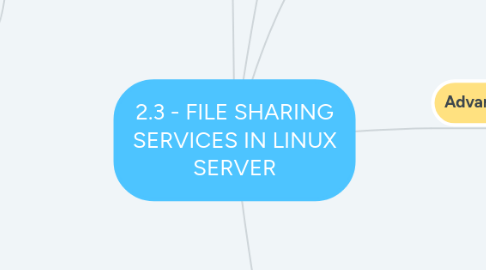
1. File Sharing services
1.1. Network File System (NFS)
1.1.1. Meaning : 1. NFS is a way of mounting Linux discs/directories over a network. 2. NFS Server can export one or more directories that can then be mounted on a remote Linux machine.
1.1.2. Main use of NFS : To share out data on a central server to all the PCs in the house. By this, you have a single copy of data accessible from a central location.
1.1.3. 3 versions of NFS : 1. NFSv2 - older and widely supported. 2. NFSv3 - more features, but not fully compatible with NFSv2 clients. 3. NFSv4 - includes Kerberos security, works through firewalls and no longer requires portmapper.
1.1.4. Advantages of NFS : 1. Local workstations use less disk space because commonly used data can be stored on a single machine. 2. Reduce the number of removable media drives throughout the network.
1.2. Samba (SMB Protocol)
1.2.1. Meaning : 1. A file sharing utility using the CIFS protocol, specifically used at allowing Windows and Linux servers to access the same file system. 2. Normal setup is to have the data drives mounted on a Linux Server and shared out using Samba and NFS.
1.2.2. Samba supported platforms : - Linux - Solaris 2.x - IRIX - Ultrix - AIX
2. Meaning :
2.1. 1. File Server provide access to files and databases for desktop/notebook users and for server-based applications.
2.2. 2. A file server enables all files to be stored in a central location, which accommodates centralized backup strategies and security implementation.
3. Advantages of Linux File Server
3.1. 1. Strong performance - Linux was made and designed to be a very strong operating system.
3.2. 2. Reliability - The Linux File Server can last for a long time.
3.3. 3. Easy to use - Rebooting process and management found to be very easy for users.
4. Common Internet File System (CIFS) Protocol Suite
4.1. Meaning
4.1.1. 1. The standard way that computer users share files across corporate intranets and the Internet.
4.1.2. 2. A network protocol whose most common use is sharing files on a Local Area Network (LAN)
4.1.3. 3. File protocol allows a client to manipulate files on a remote server. It operates as an application-layer network protocol.
4.1.4. 4. It also provides an authenticated inter-process communication mechanism.
4.2. Basic CIFS Services
4.2.1. Samba consists of two key programs, smbd and nmbd. Their job is to implement the Basic CIFS Services.
4.2.2. 1. File and print services The protocol allows clients to access shared data and printers. It is provided by key program smbd which handles "share mode" and "user mode" authentication & authorization. That is, you can protect shared files by requiring passwords.
4.2.3. 3. Name Resolution Translating a string web address such as 'jtmk.ptss.edu.my' into an IP Address such as 192.72.194.1
4.2.4. 4. Service Announcement (browsing) A browsable list of services (file and print shares) offered by the computers on a network.
4.2.5. 2. Authentication & Authorization - Authentication is the process where user's credentials are used to verify the user's identity. - Authorization is the process in which the authenticated user is allowed (authorized) access to resources.
